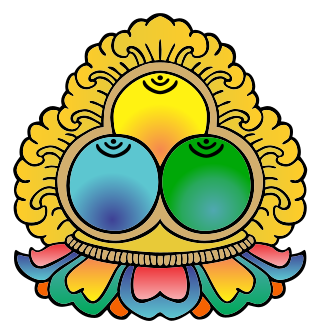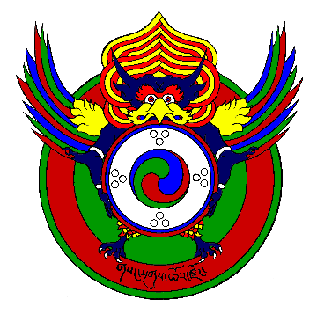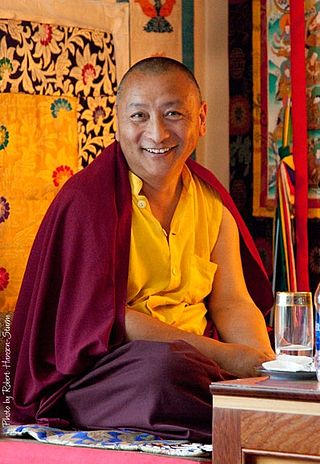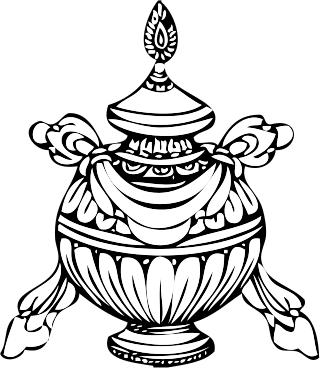
Tibetan Buddhism is a form of Buddhism practiced in Tibet, Bhutan and Mongolia. It also has a sizable number of adherents in the areas surrounding the Himalayas, including the Indian regions of Ladakh, Sikkim, and Arunachal Pradesh, as well as in Nepal. Smaller groups of practitioners can be found in Central Asia, Xinjiang, Inner Mongolia, and some regions of Russia, such as Tuva, Buryatia, and Kalmykia.

Dzogchen, also known as atiyoga, is a tradition of teachings in Indo-Tibetan Buddhism and Yungdrung Bon aimed at discovering and continuing in the ultimate ground of existence. The primordial ground is said to have the qualities of purity, spontaneity and compassion. The goal of Dzogchen is knowledge of this basis, this knowledge is called rigpa. There are numerous spiritual practices taught in the various Dzogchen systems for awakening rigpa.

Padmasambhava, also known as Guru Rinpoche and the Lotus from Oḍḍiyāna, was a tantric Buddhist Vajra master from medieval India who taught Vajrayana in Tibet. According to some early Tibetan sources like the Testament of Ba, he came to Tibet in the 8th century and helped construct Samye Monastery, the first Buddhist monastery in Tibet. However, little is known about the actual historical figure other than his ties to Vajrayana and Indian Buddhism.

The Gelug is the newest of the four major schools of Tibetan Buddhism. It was founded by Je Tsongkhapa (1357–1419), a Tibetan philosopher, tantric yogi and lama and further expanded and developed by his disciples.

The Rimé movement is a movement or tendency in Tibetan Buddhism which promotes non-sectarianism and universalism. Teachers from all branches of Tibetan Buddhism – Sakya, Kagyu, Nyingma, Jonang, Gelug, and Bon – have been involved in the promoting Rimé ideals.

Nyingma, often referred to as Ngangyur, is the oldest of the four major schools of Tibetan Buddhism. The Nyingma school is founded on the first lineages and translations of Buddhist scriptures from Sanskrit into Tibetan in the eighth century, during the reign of King Trisong Detsen.

Jamgön Kongtrül Lodrö Thayé, also known as Jamgön Kongtrül the Great, was a Tibetan Buddhist scholar, poet, artist, physician, tertön and polymath. He is credited as one of the founders of the Rimé movement (non-sectarian), compiling what is known as the "Five Great Treasuries". He achieved great renown as a scholar and writer, especially among the Nyingma and Kagyu lineages and composed over 90 volumes of Buddhist writing, including his magnum opus, The Treasury of Knowledge.

Jamyang Khyentse Wangpo, also known by his tertön title, Pema Ösel Dongak Lingpa, was a teacher, scholar and tertön of 19th-century Tibet. He was a leading figure in the Rimé movement.

Jigme Lingpa (1730–1798) was a Tibetan tertön of the Nyingma lineage of Tibetan Buddhism. He was the promulgator of the Longchen Nyingthig, the Heart Essence teachings of Longchenpa, from whom, according to tradition, he received a vision in which the teachings were revealed. The Longchen Nyingthik eventually became the most famous and widely practiced cycle of Dzogchen teachings.
In Tibetan Buddhism, Ngöndro refers to the preliminary, preparatory or foundational practices or disciplines common to all four schools of Tibetan Buddhism and also to Bon. They precede deity yoga.
Shechen Monastery is one of the "Six Mother Monasteries" of the Nyingma tradition of Tibetan Buddhism. It was originally located in Kham, Tibet, but was destroyed in the late 1950s during the Cultural Revolution and was rebuilt in Nepal in 1985.

Dzongsar Khyentse Chökyi Lodrö was a Tibetan lama, a master of many lineages, and a teacher of many of the major figures in 20th-century Tibetan Buddhism. Though he died in 1959 in Sikkim, and is not so well known in the West; he was a major proponent of the Rimé movement within Tibetan Buddhism, and had a profound influence on many of the Tibetan lamas teaching today.

Kyabje Dudjom Rinpoche Jigdral Yeshe Dorje was known simply as Dudjom Rinpoche. He is considered by many Tibetan Buddhists to be from an important Tulku lineage of Terton Dudul Dorje (1615-1672), and was recognized as the incarnation of Terton Dudjom Lingpa (1835-1904), a renowned treasure revealer. He was a direct incarnation of both Padmasambhava and Dudjom Lingpa. He was a Nyingma householder, a yogi, and a Vajrayana and Dzogchen master. According to his secretary Khenpo Tsewang Dongyal and many others, he was revered as "His Holiness" (Kyabje) and as a "Master of Masters".

In Tibetan Buddhism, the Three Jewels and Three Roots are supports in which a Buddhist takes refuge by means of a prayer or recitation at the beginning of the day or of a practice session. The Three Jewels are the first and the Three Roots are the second set of three Tibetan Buddhist refuge formulations, the Outer, Inner and Secret forms of the Three Jewels. The 'Outer' form is the 'Triple Gem', the 'Inner' is the Three Roots and the 'Secret' form is the 'Three Bodies' or trikāya of a Buddha.

The Aro gTér is a lineage within the Nyingma school of Tibetan Buddhism. The pure vision terma on which it is based teaches all Buddhist topics from the point of view of Dzogchen. The Aro gTer terma was received by Western-born Buddhist, Ngakpa Chögyam. The lineage is a ngagpa or non-monastic lineage and emphasizes householder practice and non-celibate ordination. All of its contemporary teachers are ethnically non-Tibetan.

Zong Rinpoche was a Gelug Lama and disciple of the third Trijang Rinpoche, junior tutor of the 14th Dalai Lama. He was famous as a sharp analyst and master of philosophical debate, as well as a Tantric practitioner. He was the Abbot of Ganden Shartse monastery.

The Third Bardor Tulku Rinpoche' was a Tibetan Buddhist teacher, a holder of the religious lineage of Terchen Barway Dorje. Rinpoche is the founder of a Tibetan Buddhist center, Kunzang Palchen Ling, and the Raktrul Foundation, in Red Hook, New York.

The Sheja Dzö or "Treasury of Knowledge" is a voluminous work by Jamgon Kongtrul (1813–1899). It is constituted by a root text in verse "The Encompassment of All Knowledge" and an autocommentary in prose, 'The Infinite Ocean of Knowledge'. The Treasury of Knowledge is widely considered Jamgon Kongtrul's masterpiece, covering the full spectrum of Buddhist history according to the knowledge then current in the Himalayas; the Abhidharma through the lens of Vasubandhu ; the Buddhist philosophy preserved, categorized and developed in the Himalayas; and the many streams of Buddhist sādhanā both exoteric (sutrayana) and esoteric (vajrayana), transmitted to, maintained and developed by the many trans-Himalayan lineages, such as Mahamudra and Dzogchen. The breadth of the Sheja Dzö is encyclopedic and its approach ecumenical. The root text in verse is terse and ostensibly glib approaching telegraphic. Whereas, the tone and register of the commentary is non-sectarian in regards to the many systems of Buddhadharma it enshrines. The Sheja Dzö is the central reference and general auspice work in Rimé movement literature.

Sera Khandro Kunzang Dekyong Wangmo (1892–1940) or Sera Kandro is considered an emanation of Yeshe Tsogyal, and in her lifetime was a Tertön of Tibetan Buddhist Vajrayana, a biographer and autobiographer, and a highly respected teacher. She taught Dudjom Rinpoche, Chatral Rinpoche, and the First Adzom Drukpa, Drodul Pawo Dorje, among other high lamas.
Lama Tsedrup Tharchin Rinpoche was a Tibetan Dzogchen master in the Nyingma school of Tibetan Buddhism. He was tenth holder of the family lineage known as the Repkong Ngakpas.



















